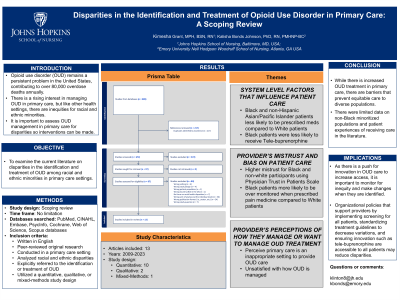(62) Disparities in Identification and Treatment of Opioid Use Disorder in Primary Care
Saturday, April 6, 2024
9:45 AM - 1:15 PM


Kimesha Grant, DNP(C), MPH, BSN, RN
Student
Johns Hopkins University, Maryland
Kalisha Bonds Johnson, PhD, RN, PMHNP-BC
Assistant Professor
Emory University, Georgia
Presenter(s)
Non-presenting author(s)
Background & Introduction: Opioid use disorder (OUD) remains a persistent problem in the United States, contributing to over 80,000 overdose deaths annually. (1) In recent years, there has been rising interest in managing OUD in primary care to increase access to treatment. (2) OUD care has long had inequities for racial and ethnic minorities. (3) Inequities in OUD identification and treatment contribute to the disproportionate increase in overdose mortality among minorities, (3) which will lead to more preventable deaths. As new models of care like primary care management rise, it is important to assess for disparities in the nascent stages so changes can be made. The aim of this scoping review is to examine disparities in the identification and treatment of OUD among racial and ethnic minorities in primary care settings utilizing both quantitative and qualitative research study designs.
Methods: We conducted a scoping review to examine disparities in the identification and treatment of OUD among adult racial and ethnic minorities in primary care settings among peer-reviewed journal articles. The search strategy was developed and conducted in collaboration with a librarian. The search strategy consisted of variations of the following key words based on the database: (Opioid Use Disorder OR OUD) and ("Primary Health Care OR "primary healthcare" OR "primary health care") and ("Healthcare Disparities"] OR "Health Status Disparities" OR "Race Factors"] OR "Minority Health"] OR disparit* OR "race factor*" OR "racial factor*"). A comprehensive search of PubMed, CINAHL, Embase, PsycInfo, Cochrane, Web of Science, and Scopus databases were conducted. Articles were included if they were: written in English, peer-reviewed original research, conducted in a primary care setting, analyzed racial and ethnic disparities among defined populations of interest, explicitly referred to the identification or treatment of OUD, and utilized a quantitative, qualitative, or mixed-methods study design.
Results: Our initial search yielded 516 unique articles. After the titles and abstracts were screened, 85 articles remained, which were reviewed in their entirety. Of the 85 articles reviewed, 11 articles were found to meet the inclusion criteria and were included in the final analysis. Of the 11 articles included, 9 utilized a quantitative study design, one was a qualitative design, and one was a mixed-methods design. The studies were conducted between 2009 and 2021. Three themes emerged from the available papers 1) provider’s perceptions of how they manage or want to manage OUD treatment, 2) provider’s mistrust and bias on patient OUD outcomes, and 3) system level factors that influence patient outcomes. Of the 11 articles, four articles contributed to the theme provider’s perceptions of how they manage or want to manage OUD treatment highlighted that providers report they are not satisfied with how OUD is managed in their primary care practices regardless of racial and ethnic population. For example, one article described the use of clinical impression for OUD identification in lieu of universal screening of all patients. Additionally, there were mixed findings among providers regarding primary care as an appropriate place to prescribe buprenorphine. Prior experience prescribing buprenorphine and not perceiving patients with OUD as unfavorable were associated with viewing primary care settings as appropriate for prescribing buprenorphine. Three articles contributed to the theme providers’ mistrust and bias on patient OUD outcomes found that providers’ trust of their patients as measured by the Physician Trust in Patients Scale, suggested providers have more mistrust towards patients who are racial and ethnic minorities and this mistrust did not align with patient-reported opioid use. Of the five articles in the system level factors that influence patient outcomes, there were numerous factors that limited access to care among racial and ethnic minorities, particularly for treatment. For example, tele-buprenorphine and medication for opioid use disorder were more likely to be prescribed to White patients compared to Black/African American patients. For individuals from racial and ethnic minoritized groups, a lack of insurance, multiple comorbidities, and acute care utilization were associated with decreased chances of receiving treatment for OUD compared to non-Hispanic White adults.
Conclusion & Discussion: While there is increased OUD treatment in primary care, our findings identify drivers of disparate care so effective interventions can be designed to address them. Three themes emerged: Provider’s perceptions of how they manage or want to manage OUD treatment, provider’s mistrust and bias on patient OUD outcomes, and system level factors that influence patient outcomes, which all contribute to disparities in care that need to be addressed. These themes align with previous studies that suggest providers may benefit from organizational support to integrate OUD treatment in primary care, (4 )which highlights implications for practice. As we push for innovation in OUD care to increase access, it is imperative to monitor for inequities while creating a plan to remedy inequities when they are identified. Organizational policies that support providers by implementing screening for all patients, standardizing treatment guidelines to decrease variations, and ensuring innovation such as tele-buprenorphine are accessible to all patients may hold promise when integrating OUD treatment into primary care.
References: 1. National Institute on Drug Abuse (NIDA). (2023). Drug overdose death rates. Retrieved from https://nida.nih.gov/research-topics/trends-statistics/overdose-death-rates
2. Korthuis, P. T., McCarty, D., Weimer, M., Bougatsos, C., Blazina, I., Zakher, B., Grusing, S., Devine, B., & Chou, R. (2017). Primary Care-Based Models for the Treatment of Opioid Use Disorder: A Scoping Review. Annals of internal medicine, 166(4), 268–278. https://doi.org/10.7326/M16-2149
3. Gibbons, J. B., McCullough, J. S., Zivin, K., Brown, Z., & Norton, E. C. (2023). Racial and ethnic disparities in medication for opioid use disorder access, use, and treatment outcomes in Medicare. Journal of substance use and addiction treatment, 209271. Advance online publication. https://doi.org/10.1016/j.josat.2023.209271
4. Austin, E. J., Chen, J., Briggs, E. S., Ferro, L., Barry, P., Heald, A., Merrill, J. O., Curran, G. M., Saxon, A. J., Fortney, J. C., Ratzliff, A. D., & Williams, E. C. (2023). Integrating Opioid Use Disorder Treatment Into Primary Care Settings. JAMA network open, 6(8), e2328627. https://doi.org/10.1001/jamanetworkopen.2023.28627
Methods: We conducted a scoping review to examine disparities in the identification and treatment of OUD among adult racial and ethnic minorities in primary care settings among peer-reviewed journal articles. The search strategy was developed and conducted in collaboration with a librarian. The search strategy consisted of variations of the following key words based on the database: (Opioid Use Disorder OR OUD) and ("Primary Health Care OR "primary healthcare" OR "primary health care") and ("Healthcare Disparities"] OR "Health Status Disparities" OR "Race Factors"] OR "Minority Health"] OR disparit* OR "race factor*" OR "racial factor*"). A comprehensive search of PubMed, CINAHL, Embase, PsycInfo, Cochrane, Web of Science, and Scopus databases were conducted. Articles were included if they were: written in English, peer-reviewed original research, conducted in a primary care setting, analyzed racial and ethnic disparities among defined populations of interest, explicitly referred to the identification or treatment of OUD, and utilized a quantitative, qualitative, or mixed-methods study design.
Results: Our initial search yielded 516 unique articles. After the titles and abstracts were screened, 85 articles remained, which were reviewed in their entirety. Of the 85 articles reviewed, 11 articles were found to meet the inclusion criteria and were included in the final analysis. Of the 11 articles included, 9 utilized a quantitative study design, one was a qualitative design, and one was a mixed-methods design. The studies were conducted between 2009 and 2021. Three themes emerged from the available papers 1) provider’s perceptions of how they manage or want to manage OUD treatment, 2) provider’s mistrust and bias on patient OUD outcomes, and 3) system level factors that influence patient outcomes. Of the 11 articles, four articles contributed to the theme provider’s perceptions of how they manage or want to manage OUD treatment highlighted that providers report they are not satisfied with how OUD is managed in their primary care practices regardless of racial and ethnic population. For example, one article described the use of clinical impression for OUD identification in lieu of universal screening of all patients. Additionally, there were mixed findings among providers regarding primary care as an appropriate place to prescribe buprenorphine. Prior experience prescribing buprenorphine and not perceiving patients with OUD as unfavorable were associated with viewing primary care settings as appropriate for prescribing buprenorphine. Three articles contributed to the theme providers’ mistrust and bias on patient OUD outcomes found that providers’ trust of their patients as measured by the Physician Trust in Patients Scale, suggested providers have more mistrust towards patients who are racial and ethnic minorities and this mistrust did not align with patient-reported opioid use. Of the five articles in the system level factors that influence patient outcomes, there were numerous factors that limited access to care among racial and ethnic minorities, particularly for treatment. For example, tele-buprenorphine and medication for opioid use disorder were more likely to be prescribed to White patients compared to Black/African American patients. For individuals from racial and ethnic minoritized groups, a lack of insurance, multiple comorbidities, and acute care utilization were associated with decreased chances of receiving treatment for OUD compared to non-Hispanic White adults.
Conclusion & Discussion: While there is increased OUD treatment in primary care, our findings identify drivers of disparate care so effective interventions can be designed to address them. Three themes emerged: Provider’s perceptions of how they manage or want to manage OUD treatment, provider’s mistrust and bias on patient OUD outcomes, and system level factors that influence patient outcomes, which all contribute to disparities in care that need to be addressed. These themes align with previous studies that suggest providers may benefit from organizational support to integrate OUD treatment in primary care, (4 )which highlights implications for practice. As we push for innovation in OUD care to increase access, it is imperative to monitor for inequities while creating a plan to remedy inequities when they are identified. Organizational policies that support providers by implementing screening for all patients, standardizing treatment guidelines to decrease variations, and ensuring innovation such as tele-buprenorphine are accessible to all patients may hold promise when integrating OUD treatment into primary care.
References: 1. National Institute on Drug Abuse (NIDA). (2023). Drug overdose death rates. Retrieved from https://nida.nih.gov/research-topics/trends-statistics/overdose-death-rates
2. Korthuis, P. T., McCarty, D., Weimer, M., Bougatsos, C., Blazina, I., Zakher, B., Grusing, S., Devine, B., & Chou, R. (2017). Primary Care-Based Models for the Treatment of Opioid Use Disorder: A Scoping Review. Annals of internal medicine, 166(4), 268–278. https://doi.org/10.7326/M16-2149
3. Gibbons, J. B., McCullough, J. S., Zivin, K., Brown, Z., & Norton, E. C. (2023). Racial and ethnic disparities in medication for opioid use disorder access, use, and treatment outcomes in Medicare. Journal of substance use and addiction treatment, 209271. Advance online publication. https://doi.org/10.1016/j.josat.2023.209271
4. Austin, E. J., Chen, J., Briggs, E. S., Ferro, L., Barry, P., Heald, A., Merrill, J. O., Curran, G. M., Saxon, A. J., Fortney, J. C., Ratzliff, A. D., & Williams, E. C. (2023). Integrating Opioid Use Disorder Treatment Into Primary Care Settings. JAMA network open, 6(8), e2328627. https://doi.org/10.1001/jamanetworkopen.2023.28627
Learning Objectives:
- Describe the current literature on disparities in the identification and treatment of opioid use disorder in primary care.
- Explain factors that contribute to inequities in the identification and treatment of opioid use disorder in primary care.
- Identify gaps in the literature on populations who experience disparities in the identification and treatment of opioid use disorder in primary care.
